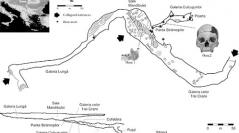

 Comptes Rendus Palevol
5 (8) - Pages 927-934
Comptes Rendus Palevol
5 (8) - Pages 927-934The 2002 discovery of the earliest European modern humans in the Peştera cu Oase (Romania) has led to systematic excavations of a bone bed (two levels), containing principally the remains of cave bears (ca. 5000 bones) and dated between 50 and 40 ka cal BP. The thanatocenosis corresponds mainly to a subadult and adult male utilization of the cavity. Levels 1 and 2 are distinguishable by different conservation processes demonstrating respectively low- and high-energy hydraulic transports. The heavy component of cannibalism may indicate bone processing for trace elements and/or a more omnivorous diet than is usually ascribed to cave bears.
Cave bear, Romania, Taphonomy, Palaeobiology, Humans